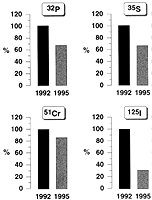
Use of common
radioisotopes at NIH
The adoption of stricter laboratory security policies in response to heightened oversight by the Nuclear Regulatory Commission has changed the way research is done at NIH. Carrying our keys at all times has become a fact of life, and we have all had to adjust to the new reality of locked laboratories and freezers as well as to a higher level of scrutiny on the part of the NIH Radiation Safety Branch.
Use of common radioisotopes at NIH |
One of NIH's responses to the growing constraints on the use of radioactive materials has been to assemble a group of NIH scientists to identify, evaluate, and promote suitable nonradioactive research methods as alternatives to the use of radioactive materials. The mission of this Committee on Alternatives to Radioactivity will be greatly aided by two favorable trends. First, the use of many common radioisotopes at NIH has declined substantially in the past four years (see figure). Second, nonradioactive methods are becoming increasingly powerful, to the point that some have already gained widespread acceptance. The success of chemiluminescence-based detection systems for western blotting, for example, demonstrates clearly that when a nonradioactive alternative is superior to its radioactive counterpart, the technique is readily adopted. The committee hopes to accentuate these trends by improving access to information on novel nonradioactive alternatives and by providing incentives for using them.
The first activity organized by the committee will be a one-day workshop and technical exhibit on May 31. The workshop will be held at Masur Auditorium in Building 10 and will consist of scientific presentations on the principles and applications of nonradioactive alternatives to many experimental procedures used at NIH. The morning session will be devoted to nucleic acid labeling and detection techniques, including Southern and northern blotting, in situ hybridization, and SSCP analysis. The afternoon session will include talks about in vitro and in vivo phosphorylation techniques, cell-surface and total-protein labeling, in vitro translation, and emerging technologies. The speakers will provide a critical assessment of the value of the different methods in terms of sensitivity, accuracy, availability, ease of use, and cost. In conjunction with the scientific presentations, there will be a technical exhibit in Building 10's Visitor Center. Representatives from approximately 30 manufacturers of reagents and equipment will distribute literature and be available for consultation on the use of nonradioactive methods. The committee strongly encourages all NIH scientists who use radioactive materials to attend this meeting and to be ready to discuss their own successes and problems with using nonradioactive methods.
We are convinced that decreasing our reliance on radioactive methods - although it will take some time and effort - will lead to better working conditions at NIH. Remember, a laboratory with no radioactive materials does not have to be locked all the time!